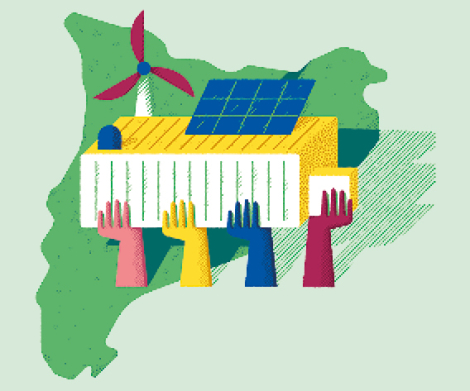Accelerate the transition to a new energy model
A new energy model for the city
- Dossier
- Jan 23
- 10 mins

We are beginning to see results after 30 years of policies to reduce emissions. Fossil fuel disinvestment is a reality, although investment in renewables is not keeping pace. However, what is needed now is to put the focus on who will control the future electricity storage and on defining the nature of hydropower concessions, required to ensure flexibility in a generation landscape characterised by the high penetration of renewable electricity, which depends on atmospheric flows, the wind and the sun.
If we have to put a start date on climate policies with media visibility, we can probably all agree that it was 1992 with the Earth Summit in Rio de Janeiro. It was there that the first commitments were made to reduce greenhouse gas emissions, such as the Kyoto Protocol and the greenhouse gas emissions market. A few years later, Canada would wriggle out of its commitments when it decided to prioritise the exploitation of the Alberta oil sands, tar sands that required unmitigated destruction of biodiversity for the extraction of the petroleum deposit. In 2015, at the Conference of the Parties in Paris, commitments to more ambitious climate targets were renewed and signed by almost 200 states. Shortly afterwards, the US Trump administration, just as Canada had done a few years earlier, backed down, with the slogan “Energy First” as its main argument.
These decisions taken by democratic countries point to the close link between the decarbonisation of the economy, energy security and competitively priced energy, which is essential to ensure the viability of companies, jobs and the welfare state.
It is no coincidence that the European Commission is seeking to take the lead in renewable energies, since the European Union is dependent on external energy sources for approximately 80% of the resources it needs to run its economy and guarantee social policies. EU member states have no oil or gas, and coal must be left buried underground to avert the acceleration of global warming.
Against this backdrop of external energy dependence, we shouldn’t expect to come across that many minimally informed European politicians who, in keeping with the denialist trend, would renege on their climate commitments in the name of energy security. Defending the interests of foreign fossil fuel-producing EU countries that, when it suits them, turn off the tap or make Europe pay for gas and oil at prices that push Europe into a corner, does not seem smart at all.
It is fair to say that we are beginning to see results after 30 years of policies to reduce emissions, climate summits, climate assemblies with political and media leadership... Fossil fuel disinvestment – and not just in coal, but also in gas and oil – is a reality. Unfortunately, investment in renewables, while high, is not keeping pace. With the rapid surge in energy demand to facilitate economic recovery in the wake of Covid-19, the balance between energy supply and demand has been thrown off kilter.
This shortfall first became evident in the summer of 2021, when the daily news broadcasts reported soaring prices on the wholesale electricity market. In less than a month, all-time highs were reached in January 2021, linked to Storm Filomena’s strong atmospheric depression, which occurred during a long period of very low temperatures, snowfall and no wind. The August 2022 price spike due to the market shortage of natural gas was accompanied by images of reservoirs being emptied in midsummer to harness water for electricity generation. So-called “opportunity costs” mean huge revenues for hydroelectric power plant owners, who use a public good (water) to push electricity prices up.
Windfall profits have been widely condemned by think tanks such as Economistas Frente a la Crisis [Economists Against the Crisis] or the Fundación Renovables for some time, but without reaching the media or widespread public knowledge. Now everyone is talking about them, even a year after the European Commission denied their existence. Last May’s REPowerEU communication: Joint European Action for More Affordable, Secure and Sustainable Energy openly acknowledged the existence of “windfall profits” and overpayments running into the millions, with a transfer of income from citizens to the big energy companies that wield considerable market power.
It is said that out of every crisis comes an opportunity. Water reservoirs are the main electricity storage system. It stands to reason that the use of a public good such as water should be used to lower electricity prices, an essential service for citizens. But we now realise that this is not the case. The debate on what to do with hydroelectric concessions has come to the fore once again, but, unfortunately – and I won’t go into the random extensions of concessions in the recent past – most of the large hydroelectric plants will still be in the hands of the big electricity companies for many years to come.
However, the focus now needs to be shifted to who will control the future electricity storage we will require to ensure the flexibility needed in a generation landscape characterised by the high penetration of renewable electricity, which depends on atmospheric flows, the wind and the sun.
Indeed, we are already seeing private initiatives to secure concessions to build future reversible reservoirs. Will they pump water when electricity is very cheap – at times of more supply than demand – and harness it when it suits them to make more money? Or will they pump water when it is necessary to lower electricity prices? This is where politics comes into play.
 Illustration. ©David Sierra
Illustration. ©David SierraThe decision on who will control future electricity storage must be made soon because we are dealing with projects with a strong impact on the territory.
I doubt that none of the parties running in the upcoming state elections will adopt a stance on the control of electricity storage in their election manifestos. And, in fact, this is a decision that will determine the economy’s competitiveness in the not too distant future, when 60% of the electricity generated will be from wind or photovoltaic power. The decision must be made soon because we are dealing with projects with a strong impact on the territory, which will take years to be approved and built. Their investors and society must have a clear understanding of the ground rules.
The Catalan government has already made its position known. This October, the bylaws of the public energy company Energies Renovables Públiques de Catalunya were approved, which envisages the investment, management and control of storage, as well as the transfer of expiring hydroelectric power generation concessions for inland basins to the public energy company. In other words, the Generalitat Government of Catalonia has already given the go-ahead for electricity storage facilities, which are strategic in their own right, to be placed under public control.
Unfortunately, if opportunities come out of crises, there are often even more opportunists who take advantage of times of uncertainty to sow seeds of doubt. In fact, almost everyone agrees on longer-term climate goals. For the time being and the immediate future, however, there is much more of a discrepancy. Many people are now arguing for a return to investment in oil, gas and coal, but they are clearly not using the classic arguments of climate deniers. Now messages are being spouted that science still has a great deal of work to do, that there is no need to invest government resources in new untested technologies that are far from being marketable… In short, there will be no shortage of arguments for investing in fossil fuel technologies and, moreover, the ground has been well prepared with the war in Ukraine. We are facing a new wave of climate deniers, so-called “climate delayers”.
While we are being convinced that we need to invest colossal sums in capturing CO2 from the atmosphere, and while we are researching future technologies (a future that is always 50 years in the future) such as nuclear fusion, many really interesting things are happening in the world that show us that the way forward is to accelerate the energy transition towards renewable energies and the electrification of transport. Moreover, this is also a response to the biggest crisis humanity is facing, climate change, which unfortunately has now been put on the back burner.
In reality, the opposite is true. If we had not stopped the commitment to renewables in the early 2010s, does anyone doubt that we would be coping better with the energy crisis now? I have no doubts whatsoever. In fact, there are now many authorities, staggered by the need to triple the 2023 budget to purchase energy, that now want immediate stop-gap measures. But it is tricky. Neither public sector procurement law is flexible, nor are those who oversee its enforcement receptive to legislative innovations by means of a Royal Decree-Law. Something similar could be said about municipal ordinances that do not allow solar roofs “because they are ugly”, and ignore the fact that it is “uglier” to go hungry because of having to pay the electricity bill.
Very interesting things are happening, steering us away from the apocalypse and collapse proclaimed by some, and towards a transformation of the energy model.
Beyond the fact that there are those who take advantage of the upheaval of any transition to try to embrace fossil fuels again, there are some very interesting and stimulating things happening in the world – and in our country too – that steer us away from the apocalypse and collapse proclaimed by some and bring us closer to a transformation of the energy model. Beyond switching from fossil fuels to renewables, they facilitate a Copernican turn in the control and ownership of energy, empower citizens and SMEs, reduce energy prices and make us independent from countries outside the European Union. In addition, this commitment is in line with the fight against climate change and improving the quality of the air we breathe, as it eliminates fossil fuel combustion.
Things are happening: Solar roofs
In 2018, shared self-consumption, or collective photovoltaic solar roofs, was banned in Spain, and individual solar roofs were threatened with a sun tax. The administrative procedure for obtaining a permit for a couple of solar panels on the roof was inclined to be an aberration. If you intended to connect the installation to the grid, you could sit back and wait.
By the end of November 2022, there were 50,000 solar roofs in Catalonia, half of which have been installed this year. Rooftops with around 400 MW installed – a nuclear power plant has 1,000 MW – which, on the ground, would occupy 700 hectares of undeveloped land that would compete with agricultural activity. A total of 400 MW of electricity generation under the control of citizens and small and medium-sized enterprises. A total of 400 MW free of inefficiencies due to the loss of electricity transmission and distribution. This (400 MW) is the power of a combined cycle power plant, such as those at Port de Barcelona or the Fòrum, but combined cycles only use 50% of the energy to produce electricity, as the rest is lost in heat (according to the laws of thermodynamics). Solar roofs, on the other hand, do not undergo transformation losses (due to the photoelectric effect). Attention will now have to be given to collective self-consumption, a key tool in densely populated urban environments, where blocks of flats with limited roof space are common.
Things are happening: Solar and wind farms on the ground
In Catalonia, in November 2022, there were 90.4 MW of photovoltaic power installed on the ground, a figure that has been reached since the first Royal Decree to promote this renewable electricity generation technology was approved in 2004. By November 2022, the Generalitat Government of Catalonia’s Directorate-General for Energy had authorised 32 new solar parks with a capacity of 80.5 MW: in less than a year, 85% of all the capacity accumulated over the last twenty years had been authorised.
These are small and medium-sized projects (from 2 to 8 ha of undeveloped land) connected to medium voltage, which bring consumption closer to generation, reducing losses and investments in the transmission grid. Projects that improve the resilience of the grid and the quality of the electricity supply and that allow for a network of interconnected municipalities to be grid-connected with renewable generation. In addition, for the necessary investments, collectively borne by citizens and small and medium-sized enterprises, these projects will be the foundation of renewable energy communities.
Things are happening: Electric cars
The electric car is much more than a means of transport; it is also a way of storing electricity and introducing flexibility into an electricity system that is increasingly reliant on weather-dependent power generation sources. Community car parks in cities, if equipped with smart charging infrastructure, can become a huge virtual battery of renewable energy management. This need for flexibility is crucial. In the city of Barcelona, fossil natural gas combined cycles do this today.
Cities and dense metropolitan areas find it very hard to generate zero-kilometre energy, simply because there is not enough space. However, the large volume of parked cars, if we organise them in car parks with smart charging, will become an element of flexibility as important as, if not more important than, local renewable energy generation.
The newsletter
Subscribe to our newsletter to keep up to date with Barcelona Metròpolis' new developments




